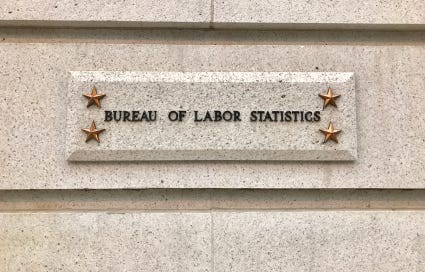Don’t Worry About Trump Tweaking Economic Numbers. Yet.
Why last week’s unemployment numbers were on the up and up
Publishers Note: Paid subscribers to The Journeyman enjoy access to an archive of over 100 essays, access to audio and video recordings of live-streamed events, and other perks via the Substack Notes app.
To make upgrading more convenient, the price of providing paid support has been reduced by 40%. This is not a sale that expires in a year. Your price will stay the same for as long as you're a paid subscriber. ~MSW
A few years ago, I was having a conversation with an acquaintance who happened to work in the financial services industry. At one point, we began to talk about the economy. The conversation was going along fine when, out of nowhere, he says, “I don’t believe these economic numbers anyway.”
The report in question showed that the economy was improving, so I was surprised to hear this sentiment from someone who was in a position to know better. But as he explained his reasoning, it turned out that his beef wasn’t with the economic numbers per se. His problem was that they made the Biden administration look good.
But it works both ways. For example, a number of people have asked me last week’s unemployment report could be trusted. This isn’t the first time this hasn’t happened.
During the pandemic, the jobs report for May 2020 contained a significant revision, due to a "misclassification error.” The change spawned a flurry of conspiracy theories asserting that Trump was changing economic numbers. The conspiracies were hogwash, as I wrote at the time.
But given that Trump has proven himself to be a one-man crime wave, it’s easy to see why many people would think otherwise. To be honest, I’ve suspected that Trump and others in his orbit might be manipulating markets to benefit themselves financially.
That being said, economic reports are a different matter. My reasoning takes a little explaining, but to borrow a quote from Joshua Doss, my favorite pollster,
“Everything's a conspiracy when you don't know how anything works."
Last week, the Bureau of Labor Statistics (BLS) released its jobs report for the month of June. Due to the Fourth of July holiday, the report, which is usually released on a Friday, was instead made public on Thursday.
Nonfarm payrolls increased by 147,000 for the month, which was higher than the estimated 110,000 jobs. Many economists and media pundits were surprised by the increase in jobs, especially because of what happened the day before.
Last Wednesday, the ADP National Employment Report, compiled by Automatic Data Processing Incorporated (ADP), released its monthly measure of nonfarm private employment. The report showed job losses of 33,000, significantly lower than the following day’s BLS data.
Because the two reports were in such dramatic opposition to one another, some have speculated that the Trump administration could be manipulating BLS data to make the numbers look more favorable. Here’s why I’m 99.999% sure this wasn’t the case.
The first thing to understand is the difference in the way that the two reports collect data. ADP collects payroll data from private corporations that utilize the company’s payroll system.
This is a huge data set, but it only represents about one-fifth of all privately-employed individuals in the United States, and omits self-employed workers.
On the other hand, the BLS report is more comprehensive, covering all sectors of the economy, including government employees. The process of compiling this data requires thousands of government employees.
The ADP report, which is the product of a private company and not the government, was also a surprise, but in the opposite direction. Economists had actually predicted an increase of 95,000 jobs. Last Wednesday’s release was the report’s first monthly job loss in more than two years.
Perhaps the strongest evidence against political influence over the BLS is that June’s report actually works against Trump’s desire for the Federal Reserve to cut interest rates.
Even before taking office, Trump has continuously pushed for the Fed to lower interest rates. Just yesterday, he called for Federal Reserve Chairman Jerome Powell to resign for resisting Trump’s demands.
If anything, the strong hiring trend reflected in last week’s report is an indication that employment was stronger than expected. That makes it easier for the Fed to leave rates where are, and gives them more time to assess the impact of Trump’s tariffs on inflation.
That’s the opposite of what Trump would like to see happen. If the White House were manipulating BLS data, last week’s jobs report would’ve reflected a result more to Trump’s liking.
Is there a scenario where the White House could fiddle with economic reports? Sure. But when other autocrats (yes, Trump is an autocrat) have tried to exert influence over their country’s central bank, it hasn’t gone well.
In 2021, Turkey’s president, Recep Tayyip Erdoğan, summarily sacked the country’s central bank governor, something that Trump has floated doing in Powell’s case. It was the fourth such firing in Erdogan’s effort to take control of the country’s central bank.
The result? A near collapse of the country’s currency. Investors fled the country’s stock markets, triggering Turkey’s worst selloff since the 2008 global financial crisis. That month, the country’s rate of inflation hit 15%.
So it’s possible, maybe even likely, that Trump could follow a path similar to Erdogan’s. After all, the guy is following the autocrat’s playbook, chapter and verse. In an interview a few months ago, Erica Groshen, a former BLS commissioner who’s now a senior economics advisor at Cornell, explains how Trump might try it.
But if the country’s economic reporting system became less reliable because of political interference, it wouldn’t be help Trump as much as you might think.








Didn’t Adolf Hitler try to swindle world bankers? It started out fine when the State (s) made money - but when they lost ~It was a wrap. Thanks for the article! Your knowledge of the markets is why I became an annual subscriber.
Wondering about your article titled “Here comes the pain”. So I have my bearings, you say it was written 4/5/25. Is it actually 7/5/25?